This slow cooker pork belly (samgyupsal) dish can be enjoyed as bossam (pork wraps) or simply as a main dish with some salad vegetables.
Back in March, I posted my slow cooker beef shank recipe and said there will be another slow cooker recipe coming soon. This one is a slow cooker version of the boiled pork, similar to bossam (보쌈, pork wraps). However, in this recipe, I created a sauce to drizzle over the pork belly. As such, it’s great to serve it as is with pachae (scallion salad) or some fresh salad vegetables. You can, of course, enjoy it as bossam with vegetable wraps.
Slow cooking pork belly renders more fat than boiling if you are concerned about the fat content of pork belly.
Sometimes, I use Boston butt (moksal, 목살) or picnic shoulder (apdarisal, 앞다리살), which also works nicely. If you’re using a big roast cut, simply cut it into 2 to 3 thick strips so the seasoning can better penetrate the meat.
Speaking of the seasoning, I used a tablespoon of doenjang (Korean fermented soybean paste) along with garlic, ginger, salt and pepper. Doenjang is commonly used in Korean cooking to flavor pork, and I also use it for the boiled version of this pork belly. You can omit it and simply use more salt if you want (I do that sometimes).
After 3 hours, the meat was tender enough but firm enough for slicing. My old slow cooker takes an additional 30 minutes to an hour to come to the same tenderness. I bought a new slow cooker mainly to test cooking time because the other one is very old. I’ve noticed a vast difference between the two. So, adjust the cooking time depending on your slow cooker, how thick your meat is, and how tender you’d like it to be.
For this recipe, I seared the meat in a pan with a simple sauce to kick it up a notch. This adds a nice flavor and color, but it’s an optional step. You can also double the sauce recipe and drizzle over the pork slices to serve. I recommend this if you’re serving it without cabbage or lettuce wraps.
For a collection of slow cooker (or crock pot) Korean recipes, visit here.
For more Korean cooking inspirations, follow along on YouTube, Pinterest, Twitter, Facebook, and Instagram.

Ingredients
- 2 to 3 whole fresh pork belly about 2 to 3-inch wide cut - 2.5 to 3 pounds
- 1 medium onions
Seasoning for the pork
- 1 tablespoon minced garlic
- 1 tablespoon grated ginger
- 2 teaspoons salt
- 1 tablespoon doenjang Korean fermented soybean paste, or use 1 more teaspoon salt
- 1/4 teaspoon black pepper
Sauce for glazing
- Double this if you want to serve with a sauce.
- 2 tablespoons soy sauce
- 2 tablespoons rice wine or dry white wine
- 4 tablespoons liquid from cooking the pork belly, strained through a strainer.
- 1 tablespoon sugar
Garnish
- Pachae 파채, (thinly sliced scallions) - 3 to 4 scallions
- A handful of radish sprouts
Instructions
- Cut the onion in half, and roughly slice each half, and place the slices at the bottom of the slow cooker in a single layer. Add 1/2 cup of water (or brewed coffee) to the slow cooker. Rub each pork belly with the seasoning mix. Place them on top of the onion.Cook on high for 3 to 4 hours (5 to 6 hours on low) until the pork reaches the desired tenderness.
- Combine all the sauce ingredients in a small bowl. Pour the sauce to a large pan, and bring to a boil over medium heat. Using a pair of kitchen tongs, add the meat and sear until all sides are nicely glazed with the sauce and the meat is slightly caramelized, a minute or two on each side. Do not burn the sauce.
- If doubling the sauce, use the same pan, after removing the meat, to boil the sauce over medium heat until slightly thickened. Adjust the salt level by adding a little bit of water if needed.
- Serve simply with the thinly sliced scallions, or serve with some lettuce and ssamjang. Drizzle the sauce over the meat if using extra sauce. See note.


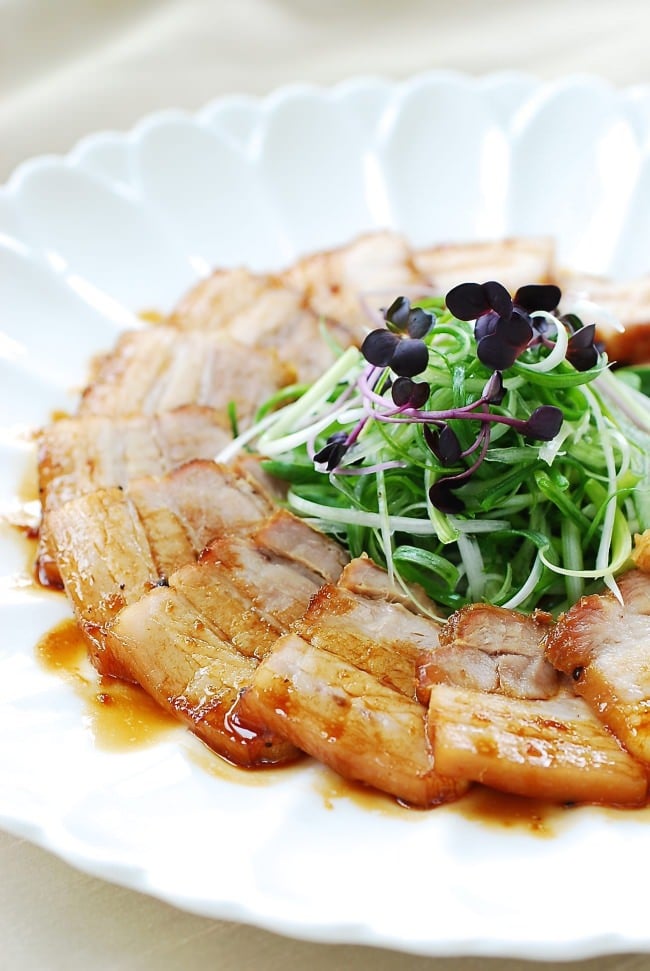
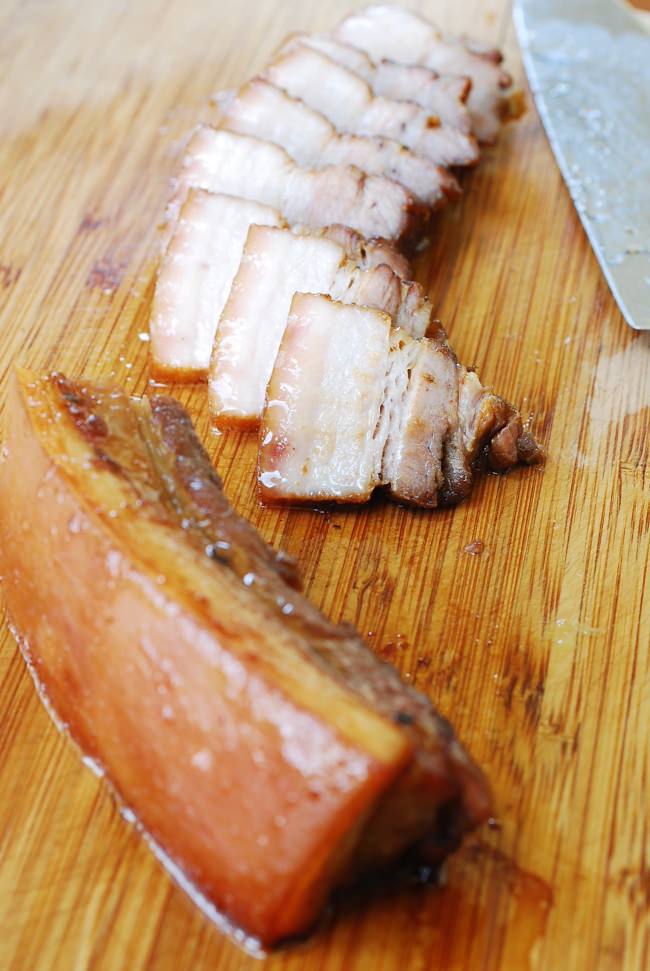
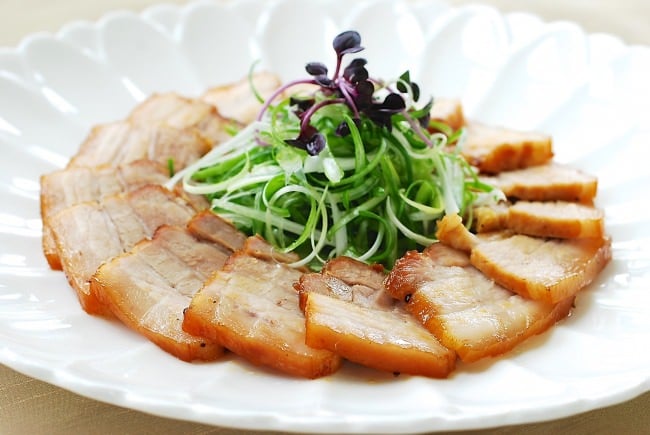
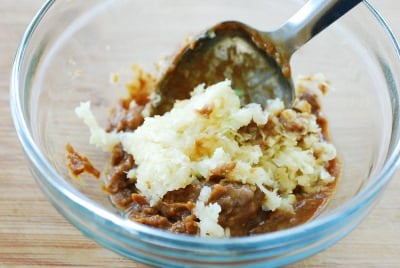
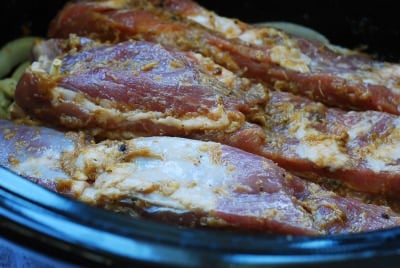
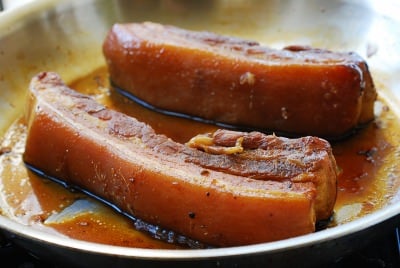
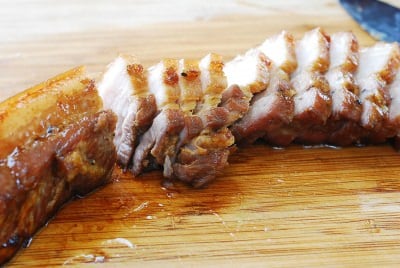
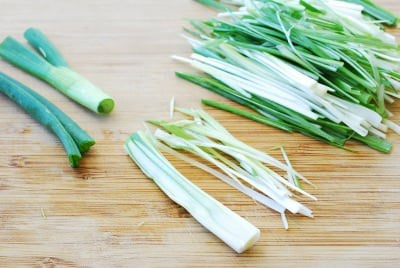
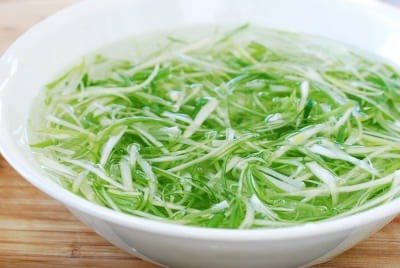

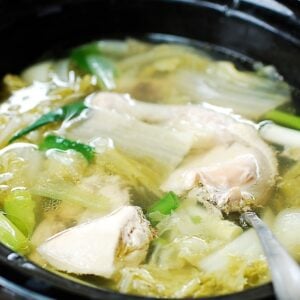
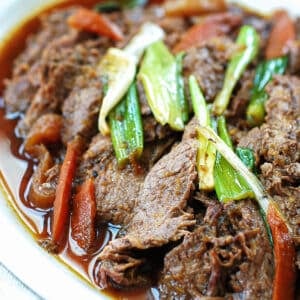
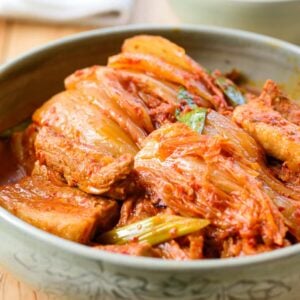













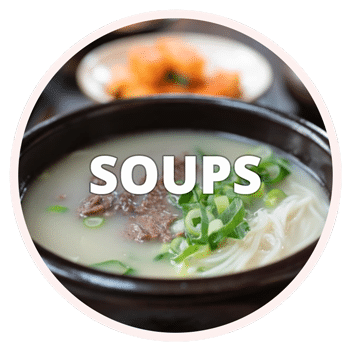



Jennifer says
Instead of doenjang I can use additional salt? Thanks to a soy allergy, doenjang isn’t an option. I have alternatives for soy sauce but have always struggled with gochujang and doenjang.
Hyosun says
Oh sorry about the late reply! Yes you can just add more salt.
Heulwen says
Tried a version with a small smoked gammon joint that we happened to have, and it seems to have worked really well! I didn’t put in quite as much salt as the recipe suggests, and even so it was quite salty, but some of that may have been from the joint itself. Instead of searing it in a pan, I put the slow-cooked joint in a small ovenproof dish and baked it in a hot oven, with frequent checking and basting, until the sauce was sticky and the meat was well glazed.
Esther says
Lovely recipe! I think the title and URL accidentally say “samgyupsal” instead of “bossam.” : )
Hyosun says
The word “bossam” refers the boiled pork dish when the meat is enjoyed wrapped in a salted cabbage leaf, traditionally, (or lettuce leaf) with some condiments such as salted shrimp and/or ssamjang. Boiled meat by itself is called suyuk, meaning boiled in water. So boiled pork belly is called samgyupsal suyuk. Here, I just wanted to show another way of cooking and enjoying pork belly, with a sauce drizzled over. Of course you can also enjoy it as bossam with some sort of ssam (wraps).
Jason says
I don’t know how you were able to keep the pork belly so shapely. Mine was literally falling apart after the slow cooker. Still tasty though!
Hyosun says
oh your slow cooker must have higher strength. Just cook less next time.
Eileen Sico says
I have learned a lot form your recipes. I have perfected japchae (my hubby thinks its better than restaurant cooking) and have been cooking bibimbap lately but Will Troy this dish for March 3 celebration. I’m sure this is delish. Thank you so much.
Vivian Park says
Wonder if I can substitute pork bellt with pork tendorloin.
Jason says
I think she mentions in the beginning, that she’s used different cuts. I’ve made this with pork belly and I think I would have preferred less fat in int.
Agnes says
Pork belly is the right cut for authenticity, you can always experiment though
Liana says
Hi! Does the pork belly need to be in a single layer? I need to double the batch and was wondering if I can stack it in the slow cooker.
Love all your recipes and have tried many.
Thank you!
Ellen says
Hi, can I make this in an instant pot instead of slow cooker?
Darryl Simpson says
A question please. Can Japanese miso paste substitute for doenjang in this recipe?
Hyosun says
Sure. It will be a little different, but still good.
Maria says
Hi what was the 4 tablespoon cooking liquid? Is that some kind of Mirin style sweet cooking seasoning?
Hyosun says
The liquid from cooking the pork belly.
Terence says
How would you change the cooking time if the pork belly was already sliced? Looks delicious!
Michelle says
Thanks for the delicious recipe! the pork belly just melts in my mouth! I ate the pork belly & scallions wrapped in lettuce leaves… so delish! What do you do with all the juice from the slowcooker pot?
EK says
Maybe I’m missing something, but my question is…what is the “cooking liquid” in the sauce for glazing?
Ruby says
Made it for dinner. It didn’t look as nice as yours since the belly slices I had were too thin. But it tastes soooo good!!!!! I used coffee in the cooking and v that gives it an awesome flavour.
Hyosun says
Happy to hear that! Coffee is always nice with pork belly. Thanks for leaving me a note! It means a lot to me.
Maria says
Do you happen to know what was the 4 tbsp cooking liquid?
Hyosun says
That’s the liquid from cooking the pork belly. Thanks.
James says
Absolutely delicious. Some of the best pork I’ve ever had! I served it with some roasted veg and potatoes for a great British/Korean Sunday roast. Perfect, thank you.
Hyosun says
That’s great to hear! Your British/Korean Sunday feast sounds really good. Thank you so much for trying out my recipe and letting me how it turned out for you! Cheers!
Tom Ng says
Hi. I thoroughly enjoy all your recipes on this blog. They’re delicious and very simple to make. Just one question for this recipe; how do you slice your onion to put at the bottom of the pot? Is it just thin half moon slices?
Hyosun says
Thank you! It really doesn’t matter, but thick slices are better for slow cooking. Enjoy!
Jay Chun says
Love the photographs and the way you explain the recipes. I have seen a lot of recipes and videos on Korean cooking, and I have to say you are the far “BEST”. THANK YOU for sharing and posting great recipes.
Hyosun says
Aww thank you so much for such generous and encouraging words! It really means a lot to me. It’s my great pleasure to share the recipes!
Nellie says
Hi! I enjoy your recipes and recommend your website to all my friends, Korean and non-Korean. In this recipe, the searing seems to give a nice color to the meat. What is the sauce you use to sear? Thank you!
Hyosun says
Thank you for spreading the word! I really appreciate it. The sauce ingredients are in the recipe. Enjoy!
Melissa says
Thanks for a great recipe! The last time I cooked pork belly, the skin was very tough and chewy. Do you have any tips for solving that problem?
Hyosun says
How did you cook it? It shouldn’t be tough if it was boiled or slow cooked. Depending on the cooking method you used, maybe you can cook a bit longer.
Seth says
Can we use black bean paste instead?
Hyosun says
Yes you can. It will taste a little different but should be fine and still delicious!
Li-Yong says
Hi Hyosun, I have made your stovetop bossam recipe a few times (and love it!) so I am stoked you have a slow cooker version. Just a question on the pachae – how do I make the tangy Soy sauce based dressing that it would be tossed with for Korean bbq wraps etc? Thank you!
Hyosun says
Thank you, Li-young! I will post that as a separate recipe, but basically add a little bit of gochugaru, sesame oil, sesame seeds, sugar and soy sauce. You can also add some vinegar if you want.
Yong says
Interested to try this recipe. Every recipe I’ve tried so far from your website has been amazing. I was wondering, do you leave the skin on the pork belly?
Hyosun says
Thank you! Yes I do, but you can remove it if you want.
Caroline says
Beautiful!
Hyosun says
Thank you!